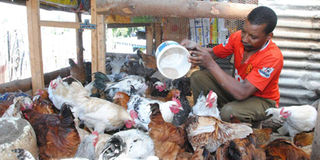DIARY OF A POULTRY FARMER: Rats, my chickens’ worst nightmare

A small scale farmer George Muthoga feeding his Croilla layers chicken in Maishani estate,Elburgon in Nakuru. PHOTO | JOHN NJOROGE | NATION MEDIA GROUP
What you need to know:
- When I got to the farm a week later, I was shocked that we’d lost 22 birds in five days despite the treatment.
After sending him some photos on WhatsApp, he advised me to start a five-day course of antibiotic called Ampro-sul.
The other week I gave a mid-term report of my run in poultry. One of the challenges I highlighted was dealing with diseases, two which ravaged my farm until I had to destock.
Now, after I wrote that piece, I’d experienced some premonitions about a new disease outbreak on the farm that I recalled a favourite line from my good professors at medical school that “diseases don’t read books”.
You see, a week before, I’d received this message from Cleophas. “I’ve isolated five growers with lesions around the comb, wattle and eyes.”
I suspected this could be fowl pox. The vet technician at the agrovet in Njiru confirmed the diagnosis and advised that we put the birds on a five-day course of an antibiotic called Tylosin-doxy and a course of multivitamins.
I called Dr Omari who confirmed that although fowl pox is a viral infection, antibiotics are recommended to cover for any secondary bacterial infections that could be fatal. “You have to complete the five-day course and give a daily dose of 60g in 60 litres of water per day,” he insisted.
When I got to the farm a week later, I was shocked that we’d lost 22 birds in five days despite the treatment.
I then called Dr Mugachia, the Vet on Call, for a second opinion. After assuring me that mortality from fowl pox is usually low, I guessed we were dealing with something else.
First, he asked me if I’d noticed swellings around the eyes or whether the birds were discharging some sticky pus-like material from eyes and nostrils. He told me this could lead to blindness, starvation and death. I hadn’t noticed this.
When I mentioned that I’d noticed a clear fluid coming from the mouth, he retorted, “Chickens don’t dribble saliva, so the clear fluid must be coming from the lungs pointing to a respiratory infection.” After sending him some photos on WhatsApp, he advised me to start a five-day course of antibiotic called Ampro-sul.
But here’s the dilemma. A few weeks ago (at week six), I’d faithfully vaccinated the birds against fowl pox (Seeds of Gold, Aug 5). If you recall, Cleophas even did the six-day post-vaccination test for “take” and confirmed that 94 per cent of the birds had the scar indicating the shot was successful.
Another thing that puzzled me about this new disease outbreak was that I’d instituted strict farm bio-security measures. (Seeds of Gold, Nov 26, 2016).
In addition to the footbaths for disinfecting the footwear, I’ve designated different footwear and protective clothing for each room. That means that if there is an infection in one section, it doesn’t spread.
I’ve also limited visitors to the farm and created an isolation room for birds showing any signs of disease. Handwashing is mandatory after touching birds.
Dr Mugachia felt that inadequate rodent and pest control procedures could be one reason for this.
For sure, rats and wild birds are still a big problem on the farm. If you ask me, if I had ready market for rat meat, I would stop rearing chicken.
You see, I’ve tried those coloured rat-poisoned pellets but as you’d guess, the rodents are too clever and they give them a wide berth.
I’ve been thinking of keeping cats, but then you just never know, they could turn predatory.
The only viable option experts have advised is to use a compound called zinc oxide which kills rats in minutes.
The problem is that once the rats notice that the substance kills, they will also avoid it.
Thankfully, the birds have recovered after the five-day course of antibiotics, but I am counting huge losses as the death count of the 12-week growers hit 38 in two weeks.





